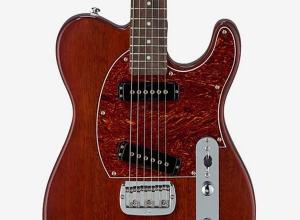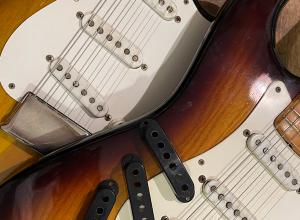Partiamo dalla chitarra, che fa parte di un lotto di produzione di Dakota Red Stratocaster realizzate alla fine del 1965, e completate all’inizio del 1966, ordinate dal distributore italiano Fender Casale Bauer. Presenta le caratteristiche tipiche di fine 1965, paletta grande, tasti “large” di fabbrica, pickup a fondo grigio dei primi anni ’66, (ancora costruiti allo stesso modo di quelli del 1965), potenziometri “stackpole”, battipenna in celluloide bianca color “porcellana” e plastica bianca leggermente ingiallita.
La chitarra ha un segno distintivo di usura sulla finitura del corpo appena sotto il ponte, che sembra una “cicatrice”, guadagnandosi così il suo soprannome.
La chitarra è stata venduta nel 2019 dal suo primo proprietario, come esemplare completamente originale. Solo in seguito però (e troppo tempo dopo l’acquisto) l’acquirente si rese conto dell’esistenza di una riparazione (non rivelata al momento della vendita) fatta sulla parete laterale della tasca del manico, dove c’era un piccolo scasso sul legno per facilitare l’accesso al truss rod.
Niente di male, naturalmente, ma chi spruzzò la vernice di ritocco sulla piccola riparazione del legno non attese che la vernice asciugasse interamente, così il manico ha ottenuto un caratteristico “segno rosso” di colore, presente proprio sopra alla data, che è, per la cronaca, marzo 1966.
Perché questo è importante? Perché il suo nuovo proprietario, preoccupato dall’aver scoperto questa riparazione, e anche un po’ infelice del fatto che non gli fosse stata rivelata dal venditore, ha iniziato a dubitare dell’integrità dell’intera chitarra, soprattutto se il manico fosse mai appartenuto davvero a questo strumento dal primo giorno in cui ha lasciato la fabbrica.
In questi casi si viene sempre a creare una sensazione ambivalente, infatti una parte di noi vorrebbe liberarsi dello strumento, mentre un’altra vorrebbe comunque tenerlo.
Dal momento che il corpo mostrava molta usura, mentre il manico era pressoché perfetto, in condizioni davvero notevoli, pensò di aver trovato ulteriore evidenza sul fatto che non potesse essere stato abbinato al corpo fin dal primo giorno.
Ma poiché amava il suono della chitarra, decise di personalizzare lo strumento con un altro manico del 1964 che era montato sulla sua “player grade” strat da concerto, e lì è rimasto, dato che lo strumento così riconfigurato (come spesso accade con le Fender) suonava meravigliosamente.
Così decise di installare il manico originale della Dakota Red Stratocaster sulla sua Stratocaster Sunburst del gennaio del 1967, il cui corpo era in condizioni originali impeccabili mentre non si poteva dire lo stesso del manico.
Lo strumento, infatti, fu acquistato da un importante negozio degli Stati Uniti con un manico in pessime condizioni, prodotto ben due anni più tardi rispetto al body, alla fine del 1968, riverniciato, con la tastiera assottigliata, fori aggiuntivi di altre meccaniche ed una strana rimodellazione sulla paletta. In questo caso, era chiaro che non fosse nato con il body fin dal primo giorno.
Quindi, in un certo senso, si sentiva come se avesse restaurato due chitarre allo stesso tempo, dal momento che il manico in condizioni eccellenti del 1966 si abbinava perfettamente al corpo altrettanto ben conservato del 1967.
Gli anni passano, ma il dubbio di aver commesso un errore di valutazione con questa chitarra è rimasto, e così, nel chiedere consiglio in merito alla questione a Francesco (CescosCornerGuitars), la prima domanda che si sente rivolgere è stata da chi questo strumento fosse stato acquistato.
Così, il proprietario ha finalmente recuperato l’accordo di vendita firmato nel 2019, ed è qui che la storia diventa interessante, dal momento che è stato possibile ricercare e documentare ogni pezzo di essa, alla fine fugando le preoccupazioni del proprietario sull’originalità del manico e rivelando una bella storia del proprietario originale della chitarra.
Infatti, il proprietario originale, il signor Gianni Meola di Trieste, è un fan di lunga data di Hank Marvin, ecco perché voleva fortemente una “Stratocaster rossa” ai tempi, ed è per questo che ha anche suonato la musica degli Shadows, tra molti altri classici, con la sua band “Gli Eredi“, attiva per oltre cinque decenni!
Ora le cose hanno iniziato ad avere un senso, dal momento che il corpo della chitarra mostrava la tipica usura del “cavo” dimenticato all’interno della custodia, e qualche segno di usura tipico delle “fibbie” delle cinture, ma nessun segno particolare causato dal sudore sul fronte e sul lato della chitarra, dove solitamente si viene a formare dopo anni di contatto tra la pelle dell’avambraccio e la finitura nitro.
Questo è dovuto al fatto che il proprietario originale suonasse sempre vestito con una camicia elegante, proteggendo così la finitura frontale sul corpo. In riferimento alla finitura del manico, così ben preservata, sicuramente lo stile della musica suonata, e l’utilizzo di corde di scalatura leggera ha contribuito al mantenimento delle ottime condizioni, anche dei tasti.
Ma il sig. Meola è anche un … pittore e restauratore di auto! Lavorando sia su auto da corsa che d’epoca, ha chiaramente fatto il ritocco della vernice (colore perfetto btw) da solo, e non lo ha rivelato all’acquirente forse perché semplicemente se ne è dimenticato, trattandosi di una nota di poco conto per lui.
Quindi, dopo una inflessibile quanto fruttuosa ricerca sulla storia della chitarra, ora era giunto il momento di rimettere insieme le cose al loro posto.
Per fortuna, Cescoscornerguitars è stato in grado di mettere in contatto tutti gli attuali proprietari di queste chitarre al fine di aiutarli a ripristinare gli accoppiamenti corretti corpo / manico di fabbrica.
Come diciamo sempre, “le chitarre ci raccontano la loro storia”, sta a noi saperla riconoscere e saperla raccontare. A volte è facile, altre volte chiaramente no, ma alla fine risulta premiante l’attitudine alla ricerca, facendo sempre del nostro meglio per raccontare la storia di chi ci ha preceduto, che è sempre indissolubilmente intrecciata con gli strumenti nel nostro caso.
In questo caso, vedere ritornare il manico “al suo posto”, è stato emozionante, infatti risulta evidente che apparteneva a questo corpo fin dal “primo giorno”, come possiamo vedere dalla “C” in pennarello nero, perfettamente trasferita dalla tasca del manico del body alla lacca trasparente sul fondo del manico.
Questo accadeva quando le chitarre, nuove di zecca e appena assemblate per la prima volta, ricevevano il marchio “Checked” (controllato) dall’operaio Fender che si era occupato dell’assemblaggio finale, e quel segno a pennarello aderiva sulla finitura nitro del manico.
Durante il lavoro di ricerca e documentazione della storia della chitarra, sono state trovate un paio di immagini originali in bianco e nero della band “Gli Eredi” e del proprietario originale, il signor Gianni che suona la sua Stratocaster del 1966, e queste ora completano perfettamente la custodia della chitarra originale “for fender” realizzata da Polverini bros.
[EN] The Rebirth of “Scar” a 1966 Fender Stratocaster in factory Dakota Red - serial 133746
This is not just the story of a nice guitar, purchased brand new in 1966 and kept for over 5 decades by the same owner, but also a great “detective” story, where the quest for Restoration and Researching upon the instrument’s origin allowed us to write about it today.
Let’s start from the guitar, which is part of a production batch of Dakota Red Stratocasters made in late 1965, and completed in early 1966, ordered by Italian Fender Distributor Casale Bauer, with the typical late 1965 appointments, large headstock, factory large frets, early ’66 grey bottoms pickups, (still built in the same way as 1965 ones), stackpole pots, “porcelain” white celluloid pickguard, and slightly yellowed white plastics. The guitar has a distinctive wear mark on the body finish just under the bridge, that looks like a “scar”, thus earning its nickname.
The guitar was sold in 2019 by its first owner, as a completely original specimen. Only later, however, (and too long after the purchase) the buyer realized the existence of a repair (not revealed at the time of sale) made on the side wall of the neck pocket, where there was a small routing on the wood to facilitate access to the truss rod.
Nothing too bad, of course, but whoever performed the spray color touch up on the small wood repair did not wait for the paint to dry entirely, so the neck got a characteristic “red mark”, visible just right above the date, which is, for the record, March 1966.
Why is this important? Because its new owner, worried about having discovered this repair, and also a little unhappy that it had not been revealed to him by the seller, began to doubt the integrity of the entire guitar, especially if the neck had ever really belonged to this instrument from the first day as it left the factory.
All too many Vintage Guitar Enthusiast understand the feeling, of finding out undisclosed issues on a guitar, a part of you still loves it, while another part would just give it away.
Since the body showed a lot of wear, while the neck was almost perfect, in very remarkable condition, he thought that was further evidence that it could not have been factory matched to the body.
But because he loved the sound of the guitar, he decided to customize the instrument with another 1964 neck that was mounted on his “favourite player” strat, a player grade instrument bought on Ebay many years ago, with a Vintage Stratocaster neck paired to a Fender Custom Shop body.
The Dakota red guitar, now reconfigured with his favourite ’64 neck (as often happens with Fender) sounded amazing and it remained like this, since it was, to him, the ultimate Strat.
Pleased with the results, he installed the original neck of the 1966 Dakota Red Stratocaster on his January 1967 Stratocaster Sunburst, whose body was in impeccable original condition, while the same could not be said of the neck.
The instrument, in fact, was purchased from an important store in the United States with a neck in very poor condition, produced two years later than the body, at the end of 1968, repainted, refretted with the fingerboard thinned, with additional holes from other tuners, additional string tree and a strange headstock reshaping. In this case, clearly not belonging to the beautiful body and pristine harness from day one.
So, in a sense, he felt like he restored two guitars at the same time, since the clean 1966 neck perfectly paired with the equally clean 1967 body, and the two sounded amazing together.
Fast forward to 2023, and the doubt of having made a mistake in judging this guitar remained, and so, while asking for advice on the matter to Francesco from CescosCornerGuitars, the first question he was asked was from whom this instrument had been purchased.
Thus, the owner finally recovered the sales agreement signed in 2019, and this is where the story gets interesting, since they began researching and documenting each piece of it, eventually dispelling the owner’s concerns about the originality of the neck and revealing a beautiful story of the original owner of the guitar.
In fact, the original owner, mr. Gianni Meola from Trieste, is a longtime fan of Hank Marvin, (that’s why he badly wanted a “red Stratocaster” back in the day), and that’s why he also played The Shadows music, among many other classics, with his band “Gli Eredi”, active over a five decades span!
Now things started to make sense, since the guitar’s body did show the typical “cable” wear on the back from resting in its case, and some “buckle” wear mark, but no real armwear from sweat was present on the guitar. In fact, he used to play always dressed up with an elegant shirt, thus protecting the front finish on the body. The absence of arm sweating wear also explains why the neck finish was still pretty much perfect, and the style of music played with small gauged strings also preserved the original factory large frets in perfect shape.
But the guy is also a... car painter and restorer! Working on both racing and vintage cars, he clearly did the paint touch up (perfect color btw) of the truss rod adjustment by himself, and he didn’t reveal it to the buyer possibly because he simply forgot about it.
So, after a lengthy and relentless research on the guitar’s history, now was the time to put things back together where they belonged.
Thankfully, Cescoscornerguitars has been able to get in contact with all the current owners of these guitars to broker exchanges that helped restore them to their factory body/neck pairings.
As we always say, “guitars tell us their story”, it’s up to us to be able to recognize it and being able to tell. Sometimes it’s easy, some other times it’s clearly not, but ultimately we shall always try to do our best to determine it.
In this case, with not much surprise at this point, the neck clearly showed it belonged to this body from “day one”, as we can see by the “C” in black pencil, perfectly transferred from the body’s neck pocket to the clear lacquer on the bottom of the neck. This happened when the guitars, brand new and just assembled for the first time, received the “Checked” mark on the body by the Fender worker who did the final assembly, and that pencil mark adhered on the fresh new nitro finish of the neck.
In the process, a couple of original black and white pictures of the Band “Gli Eredi” and of the original owner playing his 1966 Stratocaster were found, and now perfectly compliment the guitar’s case candy inside the original “for fender” case made by Polverini bros, a nice example with red lining. |
 VINTAGE VAULT
VINTAGE VAULT
 SHG MUSIC SHOW
SHG MUSIC SHOW
 PEOPLE
PEOPLE
 STORE
STORE
 - Privacy - Accordo.it Srl - P.IVA 04265970964
- Privacy - Accordo.it Srl - P.IVA 04265970964
![La rinascita di “Scar” una Fender Stratocaster del 1966 in finitura Dakota Red - seriale 133746 [IT-EN] La rinascita di “Scar” una Fender Stratocaster del 1966 in finitura Dakota Red - seriale 133746 [IT-EN]](https://www.accordo.it/cloud-assets/730x450/redazionea5/images/deco/105718_dakota-g.jpg)



































